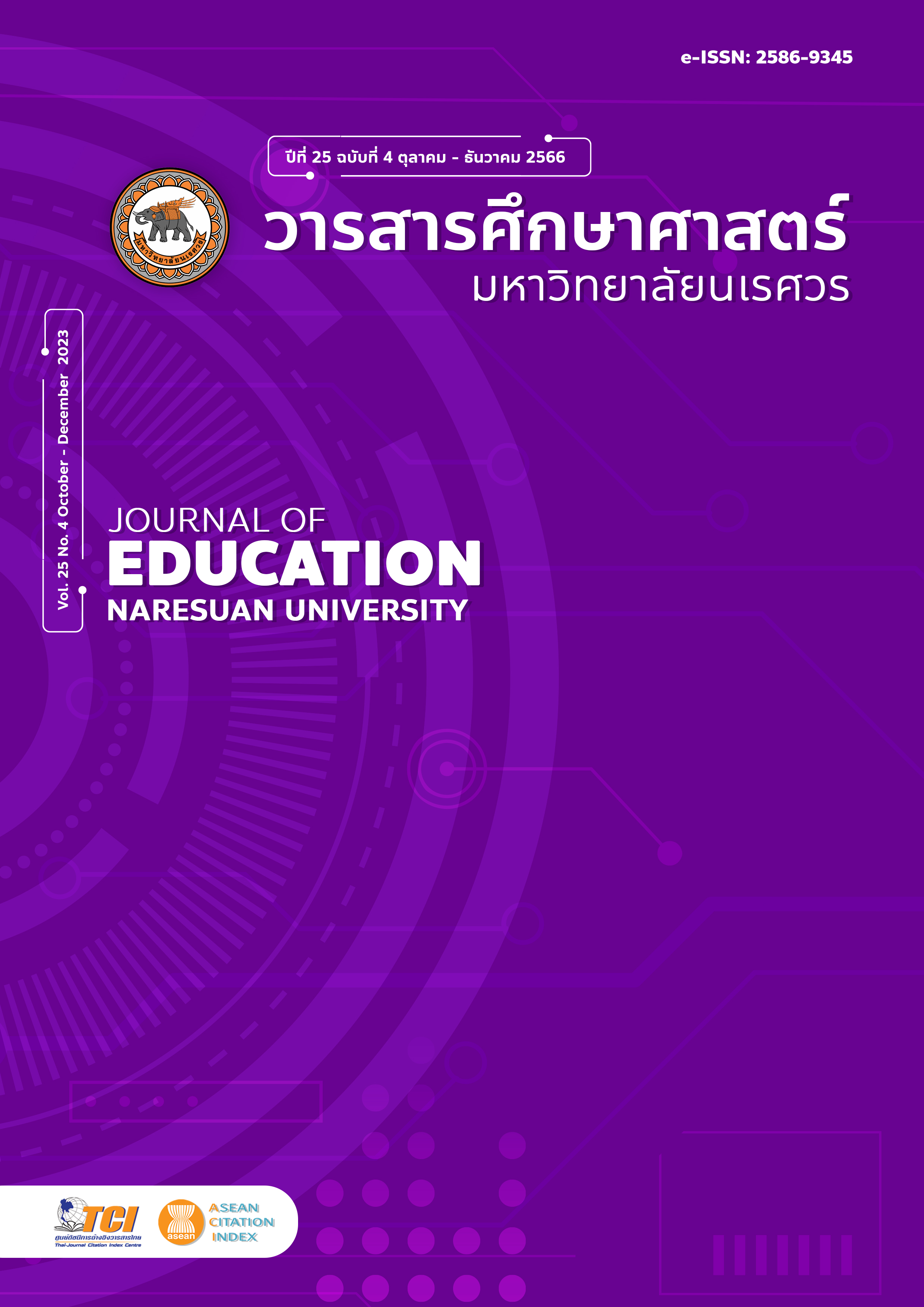THE RESULT OF UTILIZING MIXED REALITY TECHNOLOGY WITH AUGMENTED REALITY (AR) BOOK ON THAI SIGN LANGUAGE IN DAILY LIFE FOR HEARING IMPAIRED PEOPLE
Main Article Content
Abstract
The purposes of this research were: 1) to develop Augmented Reality (AR) book on Thai Sign Language in Daily life for hearing impaired people and 2) to study the results of utilizing Mixed Reality technology with Augmented Reality (AR) book on Thai Sign Language in Daily life for hearing impaired people. The sample with simple random sampling of the research consisted of 30 primary school students of Songkhla School for the Deaf. The research instruments included: 1) Augmented Reality (AR) book on Thai Sign Language in Daily life, 2) the quality assessment form of Augmented Reality (AR) book on Thai Sign Language in Daily life, 3) the learning management plan of Thai Sign Language in Daily life with Augmented Reality (AR) book, 4) the achievement test, and 5) the satisfaction questionnaire for learning with Augmented Reality (AR) book on Thai Sign Language in Daily life for the hearing impaired. The data were analyzed by computing average, standard deviation, and dependent t-test. The research indicated that: 1) the result of the quality assessment of Augmented Reality (AR) book for the hearing impaired people was at the most appropriate level, with an effectiveness of 80.96/80.03 which corresponded to the specified criteria and 2) the comparative results of the achievement test for learning with Augmented Reality (AR) book showed that the post-learning score was significantly higher than the pre-learning at the statistical significance of .01. The results of the satisfaction questionnaire for learning with Augmented Reality (AR) book on Thai Sign Language in Daily life for the hearing impaired show that at the highest level.
Article Details

This work is licensed under a Creative Commons Attribution-NonCommercial-NoDerivatives 4.0 International License.
The owner of the article does not copy or violate any of its copyright. If any copyright infringement occurs or prosecution, in any case, the Editorial Board is not involved in all the rights to the owner of the article to be performed.
References
Boonsomthop, P. (2019). Attention creation in classroom by augmented reality. Journal of Humanities and Social Sciences Mahasarakham, 38(1), 98-109. [in Thai]
Boonya, R. (2008). Sign Language: Language of deaf. Journal of Ratchasuda College for Research and Development of Persons with Disabilities, 4(1), 79. [in Thai]
Chaiyo, Y., & Siririt, W. (2017). The Development of Augmented Reality 3D book on the topic of Chinese Materia Medica for Undergraduate Students of Faculty of Oriental Medicine, Chiang Rai College. Veridian E-Journal, Silpakorn University (Humanities, Social Sciences and arts), 10(1), 471-483. (in Thai)
Department of Empower of Persons with Disabilities. (2020). Statistics of information of persons with disabilities with identity cards, classified by region and gender. Retrieved February 3, 2021, from https://www.saraburipao.go.th/home/wp-content/uploads/2020/07/สถานการณ์คนพิการ-31-มกราคม2563.pdf [in Thai]
Education Management for Persons with Disabilities Act 2008. (2008, February 5). Royal Thai Government Gazette. Volume 125, chapter 28 A. [in Thai]
Khawloueng, D., & Anukulwech, A. (2019). The development of virtual reality interactive 3D learning materials by using augmented reality (AR) technology for enhance critical thinking skill's vocational education students with different critical thinking levels. Journal of Education, 30(3), 16-29. [in Thai]
Kijjathum, P. (2004). Rehabilitation of disabled persons chapter 13 assisting deaf children and providing educational opportunities. Retrieved October 20, 2017, from http://www.tddf.or.th [in Thai]
Leelatanaporn, S. (2009). Study of behavior in children with hearing impairments. Thai Pediatric Journal, 16(1), 18-28. [in Thai]
McGriff, S. J. (2000). Instructional system design (ISD): Using the ADDIE Model. Retrieved December, 2020, from https://www.lib.purdue.edu/sites/default/files/directory/butler38/ADDIE.pdf
Meesuwan, W. (2021). The Development of a Drawing and Coloring Application by Augmented Reality Technology based on the concepts of Multisensory. Journal of Education Naresuan University, 23(2), 297. [in Thai]
Mhorsin, P., ThongDee, L., Lhasomboon, A., & Akkaranet, K. (2016). Creating online teaching media using creative theory in Thailand 4.0. The Journal of Pacific Institute of Management Science, 2(2), 161-171. [in Thai]
Na-Songkhla, J. (2018). Digital learning design. Bangkok: Chulalongkorn University Press. [in Thai]
Official of the Basic Education Commission. (1999). National Education Act of BE. 2542 (1999). Bangkok: Official of the Basic Education Commission. [in Thai]
Phoomphuk, S., & Thepnuan, N. (2018). The Development of Augmented Reality Books in Boardcast Subjects for Undergraduate Students, EAU Heritage Journal Social Science and Humanities, 8(3), 156-167. [in Thai]
Pratheppornsak, M. (2005). Learning materials for the deaf. Journal of Ratchasuda College for Research and Development of Persons with Disabilities, 1(2), 28-36. [in Thai]
Saksiriphol, D. (2010). The development of reading and spelling skill for the students with hearing impairment in Pratom Suksa III through mind map and exercises with sign language. Retrieved November 12, 2017, from http://ir.swu.ac.th/xmlui/handle/123456789/2624 [in Thai]
Somboon, P., Suphajanya, P., Chanheng, S., Jitwiriyatham, T., & Yoksuriyan, S. (2015). The research and development of multimedia for teaching assistive technology terminologies in Thai sign language. Journal of Education Research Faculty of Education, Srinakharinwirot University, 9(2), 116–127. [in Thai]
Special Education Bureau. (2020). Report of the number of students with disabilities in each study area Classified by type of disability data as of December 10, 2020. Retrieved January 19, 2020, from http://specialbasic.specialset.bopp.go.th/specialbasic/download/studentall_deform_2563_2.pdf [in Thai]
Whanset, S. (2009). Visual strategies. Retrieved May 5, 2021, from
http://www.sedthailand.com/images/column_1292399428/visual-01.pdf [in Thai]
Wiratchai, N. (2003). Overview of research report on the co-curricular management model: The development of an educational management model for children with disabilities by the family and community participation. Bangkok: Prikwhan Graphic. [in Thai]


